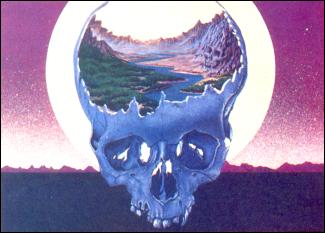| QL Software Scene |

LO! From the depths of stygian orc-burrows, from the very fundament of the Gorbals, arises Zkul, the first commercial QL adventure. Glasgow-based Talent Computer Systems has opted for a classic text adventure, set firmly in fantasyland, replete with magic words, caves and passages, jewelled treasures, a lamp that always goes out at the wrong moment and various annoying dwarfs who appear and disappear at intervals by mysterious magical means.
As one might expect with a QL adventure, the game is vast, occupying 85K RAM and containing over 300 locations, a vocabulary of similar size and plenty of logic problems, many of which are not difficult to solve.
You and your 'friend' Eldomir are involved in the usual sordid expedition picking over the cultural heirlooms of a once-mighty civilisation fallen on hard times. Needless to say, you do the adventuring while Eldomir stays behind in a little hut keeping a beady eye on the loot.
The instructions supplied with the game are detailed and include a comprehensive guide to adventuring with advice on how to find the correct words, how to negotiate mazes, and so on. Armed with all those tips and advice, even the complete novice should have no trouble.
One unusual feature of the game is the use of hints at certain stages. Instead of responding to your pleas for help, the program recognises when you appear to be in difficulty and offers to sell you a hint for points knocked off your score.
The program can scarcely be described as original as an adventure, but is clearly aware of the fact, deliberately including variations on events in the original Colossal Caves adventure by Crowther and Woods and, one point at least, directly referring to it. Viewed as an act of homage Zkul does no disservice to the original.
It is a pity that something more inventive could not have been done with the QL to show off the chip architecture and operating system. The multi-tasking environment ought to make it possible to create real-time graphic adventures of great originality, and no doubt sooner or later something along those lines will emerge. However, such innovations require a huge investment of time and programming skill, and until the industry decides the QL market is large enough to support such investment, we shall have to make do with ideas developed from existing games.
Certainly Talent deserves praise for breaking the ice with Zkul, a humorous and affectionate romp through the bygone caverns of adventuring, when Polo mints grew on walls, the magic word was PLUGH and nobody knew how to get out of the goblin's dungeon.
Chris Bourne
| ZKUL | Talent Computer Systems | Format: Microdrive | Price: £19.95 | Gilbert Factor: 7 |
THE PASCAL package, from Computer One, produces code using an intermediate symbol language which does not bear much resemblance to 68000 machine language and will only run when the Pascal operating system has been loaded into the machine. You may regard that as a little quibble but, when companies such as Metacomco are producing true machine code compilers at a cost which is little more than the Computer One package, some users - particularly in the hobbyist and serious ends of the market - are likely to be put off. The use of intermediate code also means that Pascal will run more slowly than if files were compiled into true machine code.
Despite the intermediate code Computer One has produced a powerful package the implementation of which is close to the ISO standard of Pascal. Added to the basic command specification is an instruction subset which implements the graphics features normally obtainable through the SuperBasic interpreter. All forms of graphics can be drawn including circles, curves, lines and points. Remember, however, that the language was not written for the arcade game writer.
The construction of a source program followed by editing - if necessary - and compilation is a simple process conducted from a main menu. A cursor is positioned against the task which you want the operating system to perform and the ENTER key is pressed. If you want to edit a source file, for instance, you would select the appropriate option and the Editor would be loaded from microdrive. A full screen editor, similar to the one available in Metacomco packages is available, although it is not easy to change the size of the listing window as it is with Metacomco Assembler, BCPL and Lisp.
When going through the procedure of creating a program filename a suffix is added automatically to each types of file as it is saved. That tells the operating system whether a file contains source code, intermediate code for editing, or final copy compiled code. The three-character suffix is also useful for users' reference although errors and confusion can occur if you try to load the incorrect file. You can also forget the file name extensions as they are not very memorable and you will find that constant reference to the User Guide, supplied with the package, is a necessity.
The well-written guide is supplemented by example programs on microdrive. Those include a mathematics routine which shows the numeric power of the package and the QL, a graphics display, and a simple version of the ancient puzzle Towers of Hanoi, which looks as if it could have been written for a ZX-81.
All the example programs have to be compiled from the source listings on microdrive before they can be run.
The decision as to whether to buy Computer One Pascal will depend on whether you want an intermediate or independent code compiler. The former will suffice for beginners who will find the Computer One package a delight to use. Those who are not new to Pascal, however, might want to wait for the package planned by Sinclair Research before committing themselves to one or the other.
John Gilbert
| COMPUTER ONE PASCAL | Format: Microdrive | Price: £39.95 | Gilbert Factor: 7 |